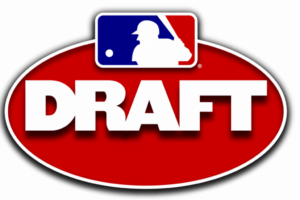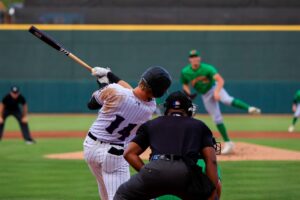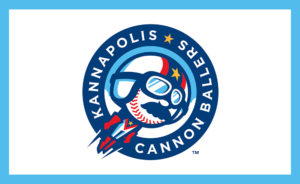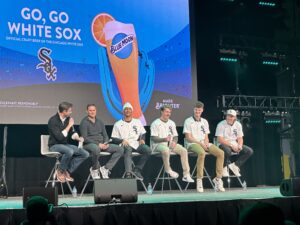First and foremost – who replaces Abreu after 2019 if he leaves?
As the major league roster stands today, the White Sox have 99 problems and first base isn’t one. Jose Abreu has been putting up All Star numbers and even getting some down-ballot MVP votes in his four seasons on the South Side. He’s also provided and will provide captain-like leadership to a young roster only getting younger, especially for some of his own countrymen. This key development phase of the rebuild should be made that much easier with Jose in the clubhouse and on the field.
Also true: Abreu is 31 years old and his current contract ends after the 2019 season. That 2019-2020 offseason should be right around the time the Sox would be looking to reach contention, give or take a year. Will the team want to spend the money it would take to re-up with him at that time? Will he still be producing at a level that would justify such a contract and a roster spot? These are questions that will need answering, and probably well before the end of 2019.
The above questions beg another – what internal options might the White Sox have around 2019 or 2020? Do any of them have high enough ceilings to even approach the overall on-field value that Abreu has provided? Or at least enough to be league average for a 1B?
First base rivals only the bullpen for roles being least interesting to prospect hounds, for a number of reasons we won’t get into here. But that doesn’t mean it’s irrelevant, as the current situation for the White Sox attests to. So let’s break down the first base talent in the organization today among those who might have a shot at filling the role on a future contending ballclub, broken into four categories.
MLB ready, lowest ceilings and positional questions
There are a pair of players who have already played in the majors, spent some time at first base and show tools that could make them playable major leaguers at first base. Matt Davidson and Nick Delmonico both seem likely to make the 2018 Opening Day roster. Both are nominally third basemen, and Delmonico also has outfielder on his resume, but neither have shown to be strong defensively. For now, Davidson seems to be relegated to DH and some time at third, while Delmonico is tentatively slated for left field.
Davidson certainly has the power you’d expect, but his strikeout rates consistently over 30% in AAA and MLB (culminating in a frightening 37.2% last year) and a .260 OBP in 2017 seem to eliminate him from the starting picture on a contending team. Delmonico put up big numbers in his 43 game look with the Sox in 2017 (.856 OPS), but his history indicates that may have been an unsustainable hot streak. Also for Nick, if he can handle left field defensively, his value is much higher there anyway. While both could be bench or role players, neither look likely to be starters on a playoff-bound club, especially at a position they’ve had only minimal experience playing.
Near ready, enough ceiling, but with a big question mark
There’s just one player in this category, and he’s one of the few that seems to have a reasonable shot at a starting MLB 1B future. Casey Gillaspie was a first round pick and had been ranked among the top 100 prospects in baseball as recently as a year ago, after a 2016 that saw him reach AAA and hit quite well in 47 games there (.909 OPS). Then 2017 happened – returning to the Internaional League, he hit .223 and slugged just .373, the walk rate dropped, and scouts started expressing major concerns about his swing and a potential inability to express game power going forward. A broken toe resulted in some missed time as well, to add injury to insult.
Was 2017 an aberration, or the exposure of flaws that can’t be fixed? His 2018 season at Charlotte should tell us pretty quickly.
Nowhere near ready
Now we are digging deep. There are a handful of legitimate prospects here, and this is the category with the best shot at producing a major league regular at the position. The problem is, none of them have played above Low-A, and some have yet to leave rookie ball. That means their arrivals are more likely in the 2020 to 2021 range if they do make it, though a couple of them could accelerate that a bit. It’s not impossible there is an heir apparent to Abreu here, but there would probably need to be an interim stopgap.
Gavin Sheets likely has the best chance to approach Abreu’s numbers as a pro in his peak years. The 2nd round pick from last June has above average to plus power potential, and has shown good pitch recognition skills, along with decent defensive abilities at the position. But he is still 21 years old and has barely seen A-ball, so even if things go very well, it would be a surprise to see him in Chicago before 2020 (a 2019 September cup of coffee would qualify as the ideal world fast track).
There are some other pure first base profiles with big power potential in the system, but all are even further away from the majors than Sheets. 20-year-old Corey Zangari has truly plus or better raw power, but he missed all of 2017 recovering from Tommy John surgery and has yet to hit successfully above rookie ball. Franklin Reyes was signed in 2015 for $1.5M from the Dominican Republic as an outfielder with 65 or 70-grade power, and has now moved to first base. Being only 19 years old and never playing above rookie ball, he’s quite a ways away. 2017 8th round pick Sam Abbott is in this discussion too, but he’s even younger at 18 and is quite raw.
Across the diamond
One of the reasons analysts don’t invest a lot of energy in first base prospects is that players from other positions sometimes end up there as their gloves fall down the skill ladder. And there are a few key prospects in the Sox system today who look to have a notable chance of moving to first base as time goes on.
People have been asking for some time if Zack Collins will really stick behind the plate. Recent reports indicate improvement there and now some analysts feel he can make it work, but the jury is still out. His offensive potential would seem to be enough to work as a first baseman, but that’s if he reaches his ceiling at the plate. And his value is much greater if he can remain a backstop, so that’s where he stays for a while at least. If after a year or two it looks like catching just isn’t working out, then he could come into the 1B picture. Offensively, assuming his hitch problem was really temporary, he could be major league ready in 2019.
Jake Burger is a top ten overall prospect in a deep ChiSox system, and some question whether or not he can stick at the hot corner. If he cannot, first base makes sense, and his high potential hit and power tools could play there. But as you likely know, Burger ruptured his achilles tendon in a Cactus League game and will miss all of 2018. Justin Yurchak has intriguing plate discipline and contact skills with some hints of power and also may not be able to stay at third, but like Burger he’s at least a couple years away. And of course in both of their cases, their value plays better at third so they’ll stay there as long as they can.
Is an internal option realistic?
There are prospects with the team today that have the potential to be average or better starting first basemen in the majors. The problem is, only Gillaspie among current first basemen could realistically be ready by 2019 and he carries a high risk of never reaching that ceiling. Collins could be ready with the bat, but he’s unlikely to make a position move at this time (though he might later). Davidson and Delmonico don’t seem to have the ceiling room to be long term options. The others are Opening Day 2020 arrivals or later, most likely. No one quite fits the bill.
The White Sox have a few choices:
- They can roll the dice and hope someone from this article leaps up and is ready by Opening Day 2020. But if that fails they will have to pay a potentially steep price in trade or free agency or end up with a below average player.
- They can attempt to acquire an MLB-ready or near-ready power first base bat this season or next, hoping they develop as projected. In this scenario they could even trade Abreu away before his contract his up and play Davidson or Delmonico in the short run.
- They can go for a reasonable extension of Abreu this year, to add 2020 (and maybe 2021) to the current contract. This means having him under contract for his age 33 season though (or more, as he may expect a longer term deal), when his skills could be in decline and putting the front office back into the above scenarios again.
We should know by a year from know which of the above paths the team could take. Meanwhile, you can use this as a guide for which players to track in 2018 as potential first basemen of the future.
Want to know right away when we publish a new article? Type your email address in the box on the right-side bar (or at the bottom, if on a mobile device) and click the “create subscription” button. Our list is completely spam free, and you can opt out at any time.








Heck,. we don’t know who is going to replace Sale and Quintana when they leave. Wait, you say they left? Doesn’t look like Kopech is anywhere near ready yet.